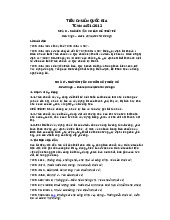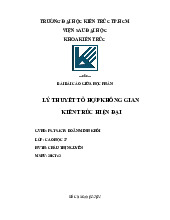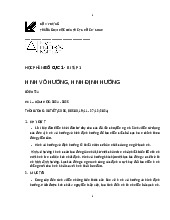




Preview text:
lOMoAR cPSD| 59256994 Văn Thiên What is solar energy?
-Solar energy is radiant energy and heat generated by the sun. This was the first source of energy used by
humans before learning the secret to making fire. Solar energy makes up the renewable energy source on the planet.
How do people harness solar energy?
-There are two methods of harnessing solar energy, active and passive.
Passive method: is to use the principle of heat capture in the structure of building materials.
Active method: A modern method that uses special equipment to collect energy from solar radiation.
Then use a fan or pump system to distribute solar power.
(Có hai phương pháp khai thác năng lượng mặt trời đó là phương pháp chủ động và bị động.
Phương pháp thụ động: Là sử dụng các nguyên tắc thu giữ nhiệt trong cấu trúc vật liệu các công trình xây dựng. lOMoAR cPSD| 59256994
Phương pháp chủ động: Là phương pháp hiện đại có sử dụng các thiết bị đặc biệt để thu nguồn năng
lượng từ bức xạ mặt trời.Sau đó dùng hệ thống quạt hay máy bơm để phân phối nguồn điện năng lượng mặt trời.)
What are the basic components of a solar power system? 1. Solar panels 2. Solar charge controller 3. Solar inverter lOMoAR cPSD| 59256994 4. Storage battery 5. ATS automatic switchgear lOMoAR cPSD| 59256994 Trần Quang
What are the benefits of solar energy?
Solar energy generates clean, renewable electricity from the sun and is good for the environment. This
alternative to fossil fuels will reduce carbon emissions inside and outside the home, thereby reducing
greenhouse gas globally. Solar energy is known to have a positive impact on the environment.
It helps to save electricity costs by not having to use the mains power. In addition, it is also possible to
sell unused surplus electricity to the power industry. No operating costs, low maintenance costs
How widely is solar energy used? lOMoAR cPSD| 59256994
Solar energy sources have been received, exploited and used by most countries around the world
In Germany, about 1.7 million solar panels have been installed on rooftops and along roads. The energy
obtained from this system is enough to replace many coal-fired power plants.
Today, thanks to government subsidies, millions of Germans have installed solar panels on their roofs. On
sunny days, solar energy accounts for nearly 30% of the total energy used.
Solar power plant in Espenhain, Leipzig, Germany
Japan is a leader in solar energy. The country's goal in 2020 will be 28 GW of solar energy and 53 GW by 2030
Since 2013, in Japan, the whole population has been encouraged to apply solar energy in the home. Solar
energy has reached an installed capacity of 6707 MW.
Fujisawa town, which has the highest population of rooftop solar power users in Japan



